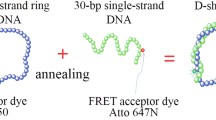Abstract.
The rotational dynamics of short DNA fragments with or without intrinsic curvature were studied using time-resolved phase fluorimetry of intercalated ethidium with detection of the anisotropy. Parameters determined were the spinning diffusion coefficient of the DNA fragments about the long axis and the zero-time ethidium fluorescence anisotropy. We find a significant decrease in the spinning diffusion coefficient for all curved fragments compared to the straight controls. This decrease is likewise evident in rotational diffusion coefficients computed from DNA structures obtained by a curvature prediction program for these sequences. Using a hinged-cylinder model, we can identify the change in rotational diffusion coefficient with a permanent bend of 13–16° per helix turn for the sequences studied. Moreover, for some of the curved fragments an increased flexibility has to be assumed in addition to the permanent bend in order to explain the data.
Similar content being viewed by others
Author information
Authors and Affiliations
Additional information
Revised version: 9 August 2000
Electronic Publication
Rights and permissions
About this article
Cite this article
Chirico, G., Collini, M., Tóth, K. et al. Rotational dynamics of curved DNA fragments studied by fluorescence polarization anisotropy. Eur Biophys J 29, 597–606 (2001). https://doi.org/10.1007/s002490000110
Received:
Accepted:
Issue Date:
DOI: https://doi.org/10.1007/s002490000110




